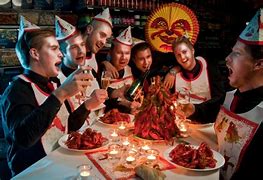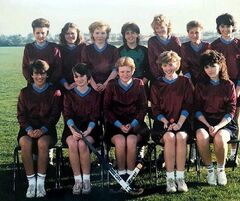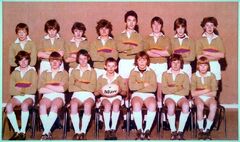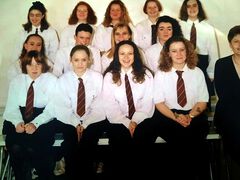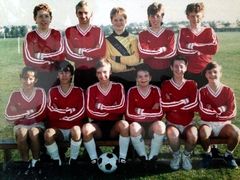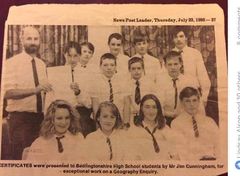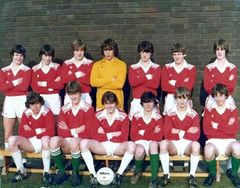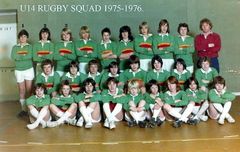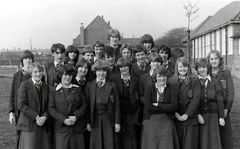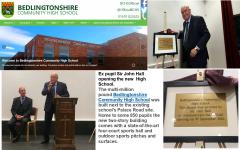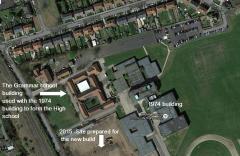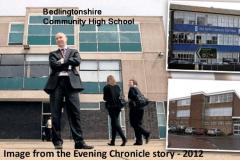.jpg.cdd7f8371d17e2f2f2e2a0e21e02f727.jpg)
Canny lass
Supporting Members-
Posts
3,607 -
Joined
-
Last visited
-
Days Won
414
Content Type
Forums
Gallery
Events
Shop
News
Audio Archive
Timeline
Everything posted by Canny lass
-
Just like that! 👍
-
... and singing (I use that word loosely)! Do I detect a hint of personal experience?
-
Looking forward to it!
-
Right country, wrong month. Crayfish premier, 5pm, first Wednesday in August. Partying usually starts any day that week when you don't have to go to work next day. Menu: Vodka, crayfish boiled with loads of dill, cheese pie (must be Swedish cheese), beer, bread, butter - in that order. It's a very messy affair and bibs and silly hats are obligatory. I think I found a suitable photo:
-
Have you tried marking (selecting) the relevant bit of text you want to respond to? When you do that a new 'button' appears which says "Quote selection". If you choose that you only get the selected text. Mind you, I don't always think it's necessary to quote anything. If your post is responding directly to the last post then a quote is hardly needed. It's just like having a conversation with someone.
-
It's about the only item I'm overjoyed about as well, Vic. I always see to it that I have some sort of cheese and ham quiche for lunch the day before - guarantees left overs that 'must be eaten before it goes to waste'. The dessert's not bad either - Vodka, strawberries and whipped cream.
-
Very sensible! Appendages are extremely neccessary when you need to fiddle about with digital maps. Good prioritising!
-
.thumb.jpg.7493ddab4a696108cf2b849323d3c155.jpg)
Bedlingtonshire Community High School
Canny lass commented on Alan Edgar (Eggy1948)'s gallery album in Historic Bedlington
-
It makes for very long reading when the whole post is quoted. Is it still ok to just highlight the relevant extract of text and use the 'quote' button that appears with the highlighting. I don't know why I'm asking this. Of course you can do that. I just did it two minutes ago! Too much celebrating this week: England, Sweden football and yesterday the biggest holiday of the year in Scandinavia - Midsommer (nothing to do with murders, mystery and intrigue) more to do with the summer solstice, vodka, pickled herring and new potatoes (in that order). Food for kings - I am told!
-
Just testing the 'quote' button.
-
Well done! Not bad for a first attempt.
-
Answers to last week's 'Bedlington Special' quiz: 1. Liver, Blue & Tan, Liver & Tan, Blue, Sandy, Sandy & Tan 2. Fact: A Bedlington Terrier cross whippet (a lurcher) 3. 3 August 1850 4. Semper Sursum 5. All of them 6. The Benedictines 7. April 2009 8. PC George Mussell and Sgt Andrew Barton. 9. Cuthbert Watson 10. John Birkenshaw 11. John Gooch and Anna Longridge 12. True 13. True 14. 1844 15. Engineer, Mr Blenkinsop, Bedlington Iron Works 16. Beside the path which traverses the Dene from Furnace Bridge up to Spring Park in Bedlington. 17. Frank Pennink 18. 27.9 miles 19. C) Waste and recycling (are the responsibility of Northumberland County Council). 20. Schalksmühle 21. Nailers 22. Michael Longridge Thank you for putting up with me! It's been an interesting experience and I've learned a lot about you in the process. For instance, I now know that I'm hobb-nobbing with people who seem to know a lot about gansters, whores, drugs, gambling, dictators and just about every alcoholic beverage known to mankind but on the other hand, are also pretty knowledgeable about things like: geography, history, languages (including Japanese!), religion, cooking, world cultures, Easter, Christmas and sport. I take my iridescent purple hat off to you all.
-
At least 4 too many! There's more pact-making than politics going on here. Biggest problem is the undemocratic way in which SD party (far right and with a similar ideology to Britain's Ukip) is being treated. While I personally do not support their views i accept that they are now the democratically chosen, third largest party in the country and as such have a right to be included in decisions affecting the country. However, Labour and Centre refuse point blank and openly to work with or include them. Much of the problem now is that Lööf (Centre) has seen fit to support their vote of no confidence in the present government. The prime minister has now two choices. By Monday he must decide if he will resign and leave it up to the speaker to negotiate with all these parties with the aim of getting together a workable government. It took 4 months last time to get a majority out of all these small parties! Or he can call another election - just one year before it's due anyway. What a waste of time, money and effort when we are in the middle of our third wave of Covid. Their time could be better spent doing other things. I think the timing for raising this vote of no confidence in the present government was appalling. Rant over!!
-
Any outburst of ecstasy thet may have been experienced on Friday didn't last long. It was cut off in it's prime by the untimely demise of the government at 10 am on Monday morning. Just what we needed in the midst of a pandemic that's causing havoc. Will try cracking open another bottle of 'celebratory' wine this evening and hope for the best.
-
You've got a goodun there!
-
Happy Birthday John. Have a really good day. I'm sure your missus will be spoiling you enormously. Where are you hiding yourself these days?
-
Thank you for that kind thought, Jammy, lilbill, Alan & Vic. I'm pleased it was appreciated. It certainly helped me put a bit of structure into my week during this topsy-turvy time we are living in. I'll certainly see what I can do for the winter months but you may not have to wait that long. The government (if we still have one after Monday) has already started to talk about tightening the restrictions - having just eased them a week ago. Needless to say my OH and myself are making the most of the heatwave and being able to see the family in reality rather than virtually - outdoors of course.. Today I have been shopping for dairy products,fruit and veg - the first time in 460 days! Who would have thought that squeezing an orange or picking through a box of potatoes could be so exciting!!! The down side was that they've managed to completely rearrange the shop in my absence so shopping took ages. Honestly, you can't turn your back for a minute!
-
Then it should give you something to do while in isolation and perhaps give even more knowledge about your home-town. If the time seems to be dragging on your own you can always look up one of the older quizes to help pass the time. Do take care, Do follow the recommendations and don't forget to wash your hands before and after handling the neighbours hedge-tr!immer. Hope the time flies by without incident.
-
Quiz time! Now that the recommendations for reducing the spread of Covid 19 have been relaxed, a little, we are planning to catch up on some quality time with the family - something we have missed a great deal these past 460 days. There's a new grandchild to get to know and wedding plans are afoot for an older grandson on return from his military posting in Mali. These occasions usually call for cake-making and dress-making. Therefpre this will be the last Friday night quiz. However, should the restrictions involve staying at home again in the future, you may well have to put up with the inconvenience again. You have astounded me with your knowledge of many things so this time let's see what you know about things nearer to home in this 'Bedlington Special: 1. What are the six accepted colours of the Bedlington Terrier breed? 2. There can be no doubt that a Bedlington Terrier exists. What about a Bedlington Whippet – fact or fiction? 3. When did Bedlington railway station open? 4. What was the motto of Bedlington Grammar School? 5. Which of the following buildings is/are Grade II listed?: Trotter Memorial Drinking Fountain, The Old Vicarage, Netherton Blue House Farmhouse 6. The parish of St. Bede, Bedlington, was established in 1876 under the care of which religious order ? 7. West Bedlington Town Council is a relatively young council. In which year was it created? 8. Name the two police officer victims of the Sun Inn murders 15 April 1913? 9. What was the name of the somnambulist who, on St Valentine’s Day 1669, climbed a buttress of St Cuthbert’s Church and fell to his death when woken by a passer by? 10. Who invented the malleable iron rails for which Bedlington Iron Works became renowned?: Michael Longridge, George Stephenson, John Birkenshaw 11. Name the parents of Sir Daniel Gooch? 12. East Sleekburn and West Sleekburn are recorded as early as 1183 in the Boldon Book. True or false? 13. Bomarsund Coal Mine, which opened in 1905, was part of Bedlington Colliery. True or false? 14. Bedlington was previously part of the County Palatine of Durham, belonging to the Bishop of Durham, When did Bedlington become part of Northumberland? 15. The first ever recorded use of a Penny Black postage stamp was on a letter sent to Bedlington. To whom and at what address in Bedlington was the letter addressed? 16. Where in Bedlingtonshire can you see the Peter Burke’s sculpture “Janus” (the god of new beginnings) which symbolizes the changing face of Wansbeck? 17. Bedlington Golf Club opened in 1972. Who designed the course? 18. Excluding its tributary, the River Pont, how long is the River Blyth from source to mouth along the river bank? 19. Which of the following services is NOT the responsibility of West Bedlington Town Council?: Bus Shelters, Children’s play areas, Waste and recycling 20. Bedlington is twinned with which German town? 21. According to an old song: Hartley Pans for sailors, Bedlington for ……………? 22. 1836, Michael Longridge opened his own locomotive works at Bedlington. His first locomotive was built for the Stanhope and Tyne Railway. What was this locomotive called? I’ll bet you didn’t know …. The French king Louis XIV hated washing so much that he only took three baths in his whole life. Answers on Thursday next week. PS. Tried to upload a photo of the statue Janus (question 16) without success.
-
.thumb.jpg.7493ddab4a696108cf2b849323d3c155.jpg)
Front Street East - for Canny Lass
Canny lass replied to Alan Edgar (Eggy1948)'s topic in Chat Central
Excellent! Thanks Eggy! -
.thumb.jpg.7493ddab4a696108cf2b849323d3c155.jpg)
Front Street East - for Canny Lass
Canny lass replied to Alan Edgar (Eggy1948)'s topic in Chat Central
Not that I'm aware of. A fletcher makes arrows. However, Fletcher is a common family name so probably the presumed butcher's/fishmonger's surname. -
No apologies needed. I didn't find it to be either facetious or sarcastic. I learned a long time ago to look at details rather than the whole. As a child, I loved those "Find five differences" games that appeared im magazines and newspapers and could spend ages perusing all small details. That experience has been very valuable in my job as I learned to look at details, rather than the whole, at a very early age. Not too many years ago I collected 3 of the grandchildren from nursery and school every day and they stayed with me until mum and dad came home from work. One of their favourite games was "Spot the difference". While we waited outside the door, one child remained in the sitting room and changed one item in some way. Then we entered and had to spot the difference. Good fun. I needn't tell you how useful it is when you are doing family research.



